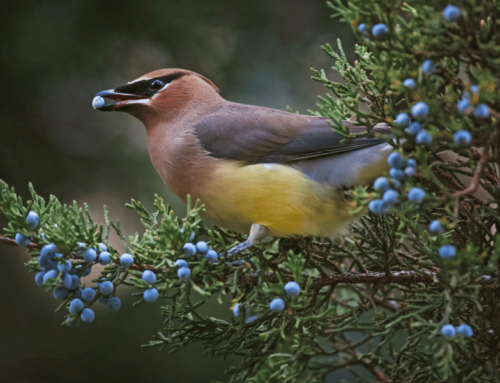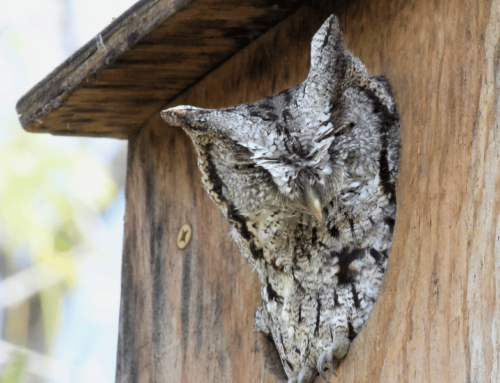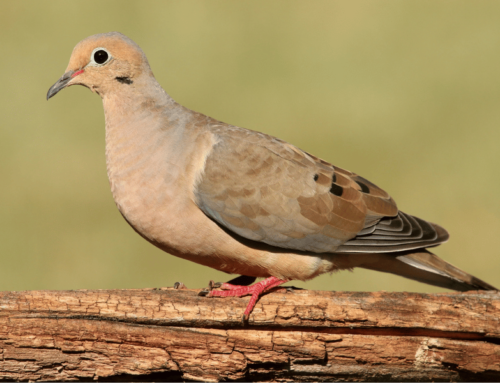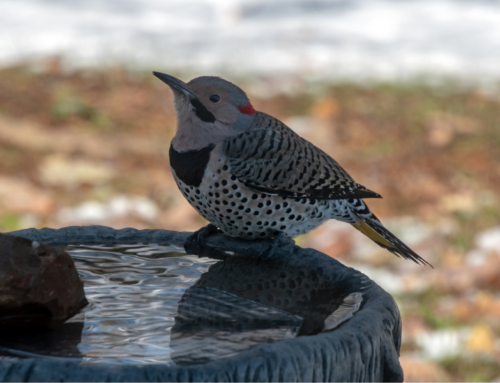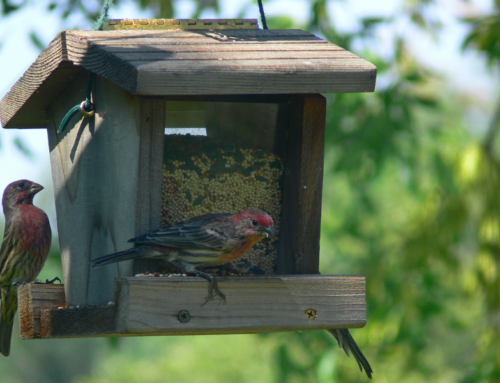Northern Cardinals are a fun and beautiful bird to watch in the wild or in your backyard. They are the state bird in seven states. Their bright red plumage has made them a popular bird among birdwatchers and backyard birders.
To increase the number you see, you’ll need the following backyard birding tips in regard to what they eat, what their calls sound like, what their range is and what sort of structures they like to nest in.
This post is all about backyard birding tips for attracting northern cardinals.
Backyard Birding Tips for Attracting Cardinals
1. Background Info
The Northern Cardinal is part of the genus Cardinalis. There are currently 19 recognized subspecies. They were once common as pets but their ownership has since been banned. Adults get up to 9 inches (23 centimeters) in body length. Besides the red plumage overall, they can be recognized by the black mask that surrounds their eyes and beak. Despite appearances, they are not closely related to the Blue Jay or Stellar’s Jay, which are both corvids.
They seem to be well-adapted to different types of habitats including wetlands, woodlands, shrublands and even in some desert areas.
Cardinals have been known to live as long as 15 years, although this isn’t typical.
Their name comes from cardinals in the Roman Catholic Church, who wear red robes during mass.
Their normal predators include crows, squirrels, owls, falcons, hawks, snakes and house cats.

2. Males and Females Appearance
Northern Cardinals, like lots of other birds, exhibit sexual dimorphism. The males are much more colorful than the females. The males will be red overall, with the females having sparse amounts of red on their wings, tail and head. Both will have black around their eyes and beaks.
During molt, they lose their head feathers. This appearance looks odd and makes them look like a totally different bird. The male’s head normally appears red from the feathers but their actual skin is much darker. During this time, they resemble small vultures but will return to their normal look in a few weeks.
The male’s deep red color is kept year-round. Due to their lack of migration, this makes spotting cardinals easy in snowy areas in winter, due to their bright red contrast with the white snow.
You can tell how a Northern Cardinal is feeling by its crest. If the crest is raised, then it’s agitated or aggressive. When they are more relaxed, the crest is lowered.
3. Fledgling Appearance
Young northern cardinals look similar to adults but with less red plumage. They usually first develop their red color on their tail and will develop their crests early in life, around two weeks into fledging.
4. Rare Yellow Morph
In rare cases male northern cardinals can appear yellow. If you’re familiar with the appearance of the males, you should be able to recognize these individuals when they’re yellow. There are no differences other than coloration.
These rare individuals lack the necessary enzymes to create red pigment like normal.
5. Eating Habits
Northern Cardinals are granivores. They eat weed seeds, grain, leaf buds, flowers and grasses. They will also eat fruit and insects and snails. Ants, spiders and grasshoppers are common prey items. However, any insects or arachnids that are small enough can be food for them. If your yard has a pest problem, cardinals can help keep those pests in check.

6. Range
Cardinals are found throughout the eastern half of the United States, southeastern Canada and down to the southwest in Arizona and New Mexico.
As you can tell from the following range map, the northern cardinal is not a migrating bird. It stays in its range year-round. In central America, they can be found in most of Mexico and parts of the northern parts of Guatemala and Belize.
Their range has extended north in the past couple of centuries. This is likely due to their ability to adapt to human development, where we often provide them with food. After being introduced by people, there is now a population on the Hawaiian Islands.
If you don’t live in these regions, you’ll have to travel if you want to see them.
7. Calls and Singing
Female and male northern cardinals will both sing. It’s now believed that over 60% of female songbirds sing and northern cardinals are among them. In other species, the males are the only ones who sing. The song from both sexes is actually different but can’t be distinguished by the human ear.
The following is an example:
8. Water
Water is important for drinking and bathing. Getting a bird bath will help with attracting cardinals along with getting other birds to your backyard as well. Three inches is an ideal depth for cardinals. Another option is to get a bird waterer, which will allow birds to drink but not bath.
Bird baths and bird waterers are especially attractive in the summer and if you live in a warmer climate.
9. Nesting in your Backyard
Northern Cardinals are not big fans of birdhouses and nesting boxes. If you want them to nest on your property, you’re going to need to dense planting. Tall trees, grapevines, hawthorn, rose bushes and dogwood plants are popular nesting plants for them. Research these plants and trees to see if they are appropriate for your residence.
When they start to nest in your backyard, give them proper respect and do your best to avoid getting too close.
10. Birds that are easy to confuse with Cardinals
Northern cardinals can be confused with a few other birds. The females are easier to confuse for other birds as they are much browner. However, there are a few species that can resemble the adult males.
-Desert Cardinal:

The Desert Cardinal is a close relative of the northern cardinal. Naturally, they look pretty similar. Hybridization sometimes occurs between these two populations. This bird also has an overlapping range with the northern cardinal. Desert cardinals are browner overall. Males of both birds have more red than their females counterparts.
-Vermillion Cardinal:
Image provided by Felix Uribe. License
This cardinal species does not overlap in range with its Northern cousin. This Vermillion cardinal is found in South America, in Colombia and Venezuela. However, either species could become a vagrant in the other’s range. In this rare event, it’s best to know the differences.
Male vermillion cardinals have less black around their eyes and upper chest and have larger crests.
-Vermillion Flycatcher:

This bird’s range overlaps with the northern cardinal’s. Vermillion flycatchers are red with a black mask, making them easy to confuse with cardinals. To tell the difference, look at the wings. The flycatcher will have black wings, instead of red wings. Cardinals will also have more robust beaks designed for cracking seeds.
-Summer Tanager:

This bird is similarly sized and appears red as well. Summer Tanagers have a lot of overlap in their range with cardinals. They can be recognized by their lack of a black mask along with their lack of a crest.
11. Nesting and Reproduction Behavior
Male northern cardinals play a big part in raising chicks. Unlike many other songbirds, the males help with building nests, along with feeding and protecting the nest area. Males actively defend their territory from intruders. They will stake out their territory by perching high on a branch and singing.
Mating season starts in March and ends in September. These birds are monogamous during the mating season, although they can switch partners in the following season. Males will stake out their territory during mating season with their songs. Between 2 to 3 clutches are laid between a single mating pair each year.
Nests are made by the female and are found at least 3 feet off the ground but usually no higher than 10 feet. The eggs are small, white with brown/grey spots.
12. Feeding
If they live in your area, getting more of them to your backyard shouldn’t be difficult. As mentioned before, seeds and grain make up the majority of their diet. These days, you can buy bags of seed that are specifically designed for cardinals. Otherwise, you can use sunflower and safflower seeds. Safflower has the benefit of being disliked by squirrels.
When picking a feeder, keep in mind that Northern Cardinals aren’t small. Smaller feeders might not be stable enough for them.
Northern Cardinals like eating with cover. If you have large bushes or trees, place the food near or beneath them. They also enjoy eating food off the ground. You can scatter seed under trees and brush which they will find attractive.
Note: If you have mirrors in your backyard, you should remove them. At least, move them away from any nesting or feeding area. Cardinals will attack them incessantly, thinking its another bird. This applies to reflective windows as well. Close your blinds or put objects closer to the window to make it less reflective. It usually doesn’t cause much physical damage to the bird, but it can cause unneeded stress.
Conclusion:
Northern Cardinals are beautiful and interesting birds to have visit your backyard. Follow the backyard birding tips in this article and you’ll increase the number of them you get to watch.


